Holiday Budget System Buyers' Guide
by Zach Throckmorton on November 8, 2011 12:00 AM ESTMotherboards and Features
As mentioned earlier, Cougar Point chipset-based motherboards are fully diversified into every cost niche of the motherboard market. While cutting-edge, flagship motherboards garner the most attention from enthusiasts, inexpensive, no-frills boards are generally just assumed to all be more or less equivalent in performance. But does performance vary between these budget boards? We briefly benchmark a few important motherboard features: LAN, SATA, and USB 2.0 throughput. But before we get to the benchmarks, let's compare features.
I tested eight different budget motherboards—four socket AM3 with AMD chipsets, one FM1 with the A55 chipset, and three based on Intel chipsets (all LGA 1155). Here's a quick rundown of the various features for each board.
| Product |
Platform/ Chipset |
Price |
RAM slots |
Rear USB ports |
LAN |
Graphics ports |
SATA ports |
Expansion slots |
| ASRock A55M-HVS |
FM1 / A55 |
$59 | 2 | 6 USB 2.0 | 1Gb | VGA, HDMI | 6 |
1xPCIe x16 1xPCIe x1 1xPCI |
| ASRock 880GM-LE |
AM3 / 880G + SB710 |
$55 | 2 | 6 USB 2.0 | 1Gb | VGA, DVI | 6 |
1xPCIe x16 1xPCIe x1 2xPCI |
| Biostar A780L3L |
AM3 / 760G + SB710 |
$50 | 2 | 4 USB 2.0 | 100Mb | VGA, DVI | 4 |
1xPCIe x16 2xPCI |
| Biostar A870U3 |
AM3 / 870 + SB850 |
$70 | 4 |
2 USB 2.0, 2 USB 3.0 |
1Gb | VGA, DVI | 6 (6Gb) |
1xPCIe x16 1xPCIe x4 2xPCIe x1 2xPCI |
| MSI 760GM-P33 |
AM3 / 760G + SB710 |
$55 | 2 | 4 USB 2.0 | 1Gb | VGA | 6 |
1xPCIe x16 2xPCIe x1 1xPCI |
| ASRock H61M-VS |
LGA1156 / H61 |
$54 | 2 | 6 USB 2.0 | 100Mb | VGA | 4 |
1xPCIe x16 1xPCIe x1 |
| Biostar H61ML |
LGA1156 / H61 |
$60 | 2 | 4 USB 2.0 | 100Mb | VGA, DVI | 4 |
1xPCIe x16 1xPCIe x1 2xPCI |
| MSI H61M-P21 |
LGA1156 / H61 |
$55 | 2 | 4 USB 2.0 | 100Mb | VGA | 4 |
1xPCIe x16 3xPCIe x1 |
One thing to note is that of the above motherboards, Biostar and MSI offer 3-year warranties while ASRock offers a 1-year warranty. As you can see, in general, you'll get more for your money from an AMD-based motherboard than an Intel-based motherboard. That is, none of the Intel boards offer Gigabit ethernet, and only one offers DVI in addition to VGA connectivity; the FM1 board is also the only board with an HDMI port. Do the Intel platforms instead offer better performance? Let's find out.
Benchmarks
While we did not perform thorough testing like when we review a specific motherboard, we tested three important metrics for all eight boards: USB 2.0 performance, SATA throughput, and LAN performance.
USB 2.0 performance
We used a Mushkin Ventura Pro USB 3.0 flash drive and CrystalDiskMark 3 to test the sequential write and read speeds of a 1000MB file. While the Intel boards tend to perform better than the AMD boards, the differences here are very minor and would likely not be noticeable in real world scenarios. The single USB 3.0 equipped board would of course be able to run quite a bit faster with an appropriate USB 3.0 flash drive.
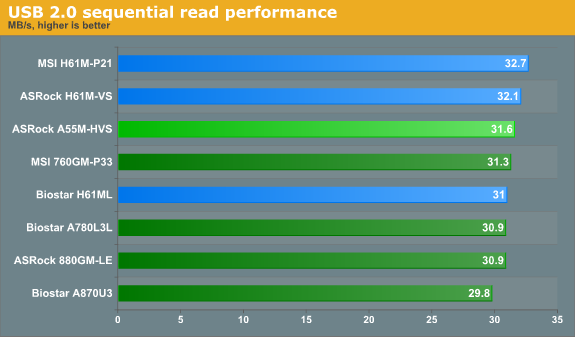
SATA performance
To test SATA performance, we again used CrystalDiskMark 3 to measure the sequential write and read speeds of a 1000MB file—with a Patriot Pyro 120GB SSD. This SSD is one of today's top performers and costs nearly $200—well above the budget sector. However, prices on SSDs will only fall as time passes, and this SSD illustrates what these boards are capable of better than a mechanical HDD. From these results, it's clear that all of the boards perform very similarly in terms of SATA throughput.
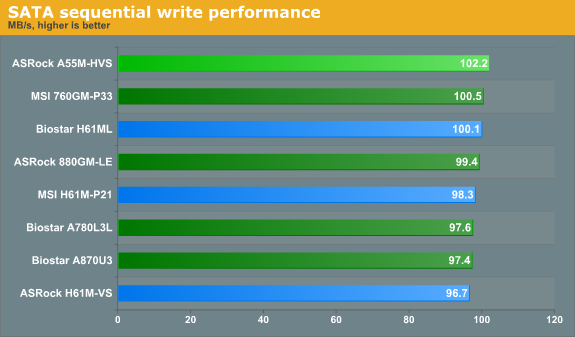

LAN performance
LAN Speed Test is a freeware program designed for testing the network connection between two PCs on a home network. The speed of the transfer is limited by the lowest common denominator on the network, so if you have gigabit ethernet capable computers but a 100 Mbit capable router, you are limited to 100 Mbit transfer. For this test, we use LAN Speed Test to transfer a 1000 MB file across a home network with a 100 Mbps lowest common speed to the same machine each time, in a write/read scenario. It is critically important to note that if you plan on attaching any of the Intel Cougar Point chipset-based boards in this guide to a network, you will be limited to 100 Mbps transfers as none of them have Gigabit adapters.
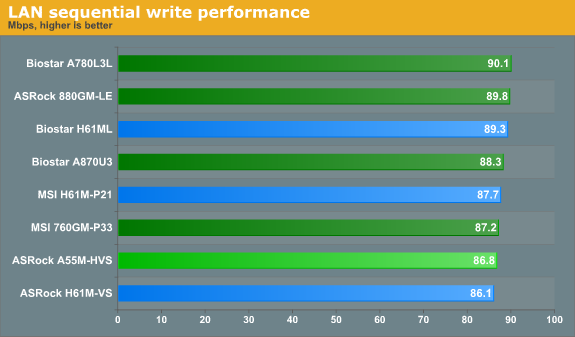
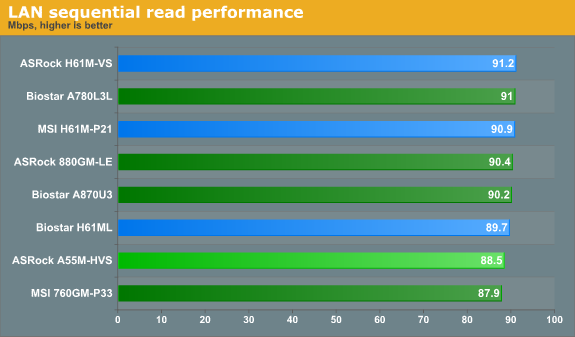
From these benchmarks, it appears that the budget boards are mostly equivalent performers. I was heartened to experience neither anomalous behaviors nor frustrating issues with any of the boards in the course of testing. Though it's somewhat disappointing to not find a hidden gem, it is useful to know that many budget boards are solid performers—so savvy consumers can watch for sales and rebates.
We cover the rest of the system components on the next page.


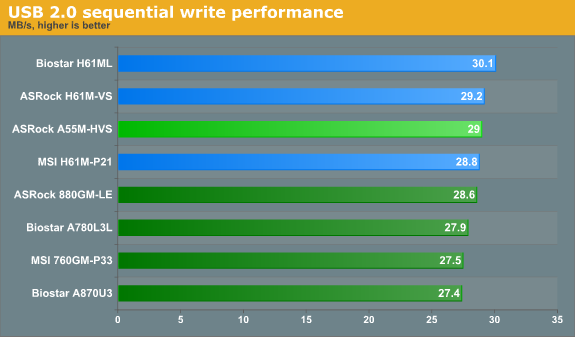








95 Comments
View All Comments
Taft12 - Tuesday, November 8, 2011 - link
Non-terrible graphics performance and a Windows install free of "value-add" bloatware for startersslayernine - Tuesday, November 8, 2011 - link
Did I just hear you say Intel onboard graphics offer "Non-terrible graphics performance" ? I hope you are just trolling me because that may just be the most ridiculous statement I've seen all day.slayernine - Tuesday, November 8, 2011 - link
This comment system lacks an oh crap how do I delete that last post function. I get what you are saying taft12, you are saying a budget system not using onboard graphics allows for non-terrible graphics.Esben84 - Tuesday, November 8, 2011 - link
Thanks for an interesting article. I like that there's also focus on more budget oriented systems. It's not everyone that needs high-end components like us enthusiasts. Though I find it difficult to recommend building budget systems, when the prebuilt ones can be found so cheap. At work I've introduced the Vostro 460 basic config, and now we are now up to using 7 in total. They've been on offer for a long time now. We buy the basic config, which in the US costs $469 and it includes a Core i5-2400 quad-core Sandy Bridge CPU, H67 chipset, 2 GB memory, 320 GB harddrive, GBit LAN, Win7Pro, HDMI connector and Intel HD Graphics 2000. It's quiet, very cheap and it's a decent looking case. Only 2 GB extra memory is needed, and if used with two digital monitors, a cheap graphics card. With such a fast system, it feels very bottlenecked by not having an SSD. If only they would add a DisplayPort and change the harddrive to a 64 GB SSD, this would be the perfect system.Esben
Copenhagen, Denmark
Halnerd - Tuesday, November 8, 2011 - link
Why would you compare the APU($70) vs a Celeron($60) + AMD5670($70)? The Celeron had a built in GP, right? The APU would be expected to perform markedly slower than a CPU and discrete GPU. You need to run both the APU and Celeron with and without AMD5670 for proper comparison. This section of the article is ridiculously lopsided.frozentundra123456 - Tuesday, November 8, 2011 - link
well, to be fair, he did test the Athlon with a discrete GPU too. He did basically say that the integrated GPU on the Celeron was worthless for gaming except in the very undemanding LFD 2.However, I agree with you in that I would have liked to see a comparison between the HD2000 of the Celeron and whatever integrated graphics the Athlon had (HD 4200??).
Maybe some older, non-demanding games or whether the integrated GPUs could handle 1080p video or Netflix streaming, or whatever. Or at least address whether the APU of the Llano offered any improvement over the other two integrated solutions (except in gaming) for the typical uses of such a budget system.
Wierdo - Tuesday, November 8, 2011 - link
Yeah makes no sense, the article's writing is so unfocused, the goalposts keep moving allover the place. For example, showing benches of Llano product vs X2 product + video card, but then in the build section using integrated mobo video card with the X2, wth.Interesting collection of info if you ignore the goal of the article though.
Halnerd - Tuesday, November 8, 2011 - link
Yeah, It would have definitely been more informative had they run all three CPU's with and without a discrete GPU. That would have given us a good idea of the full capabilities of each, whether for HTPC or gaming. As it stands the test methodology is bunk.Taft12 - Tuesday, November 8, 2011 - link
Agreed, it would allow a conclusion that points out the tradeoffs made between the 3 platforms. None are truly better or worse than the others, just different strengths and weaknesses.The article was actually terrific until the gaming benchmarks. That's when things went off the rails.
Halnerd - Tuesday, November 8, 2011 - link
I would really like to see some analysis of the socket FM1 Athlon II X4 631. That is a really interesting product at around the same price point. Might be a winner if we are going to look at discrete GPU solutions. A full review of the 631chip (or any other FM1 Athlons you can get your hands on, i.e. 641?) would be very awesome.